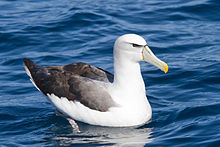bio.wikisort.org - Animalia
Aequornithes (dal latino aequor, distesa d'acqua e, dal greco, ornithes, uccelli), o veri uccelli acquatici[1] sono definiti come "il clade meno inclusivo contenente Gaviidae e Phalacrocoracidae".[2]
| Aequornithes | |
|---|---|
 | |
| Classificazione scientifica | |
| Dominio | Eukaryota |
| Regno | Animalia |
| Phylum | Chordata |
| Classe | Aves |
| Clade | Ardeae |
| Clade | Aequornithes Mayr, 2010 |
| Clade | |
| |
La monofilia del gruppo è attualmente supportata da numerosi studi filogenetici molecolari.[3][4][5][6]
Aequornithes include i cladi Gaviiformes, Sphenisciformes, Procellariiformes, Ciconiiformes, Suliformes e Pelecaniformes. Non include diversi gruppi non correlati di uccelli acquatici come fenicotteri e svassi (Mirandornithes), uccelli costieri e alche (Charadriiformes), o gli Anseriformi.
Sulla base di un'analisi dell'intero genoma degli ordini di uccelli, i kagu e il tarabuso del sole (Eurypygiformes) e le tre specie di fetonte (Phaethontiformes) insieme designate come Eurypygimorphae sono il sister group più vicino ad Aequornithes nel clade Ardeae.[1]
Cladogramma basato sugli studi di Burleigh, JG et al. (2015):[7]
| Aequornithes |
| ||||||||||||||||||||||||||||||||||||||||||||||||||||||
Note
- E.D. Jarvis, Whole-genome analyses resolve early branches in the tree of life of modern birds, in Science, vol. 346, n. 6215, 12 dicembre 2014, pp. 1320–1331, DOI:10.1126/science.1253451, PMC 4405904, PMID 25504713.
- G. Mayr, Metaves, Mirandornithes, Strisores and other novelties – a critical review of the higher-level phylogeny of neornithine birds, in J Zool Syst Evol Res, vol. 49, n. 1, February 2011, pp. 58–76, DOI:10.1111/j.1439-0469.2010.00586.x.
- S.J. Hackett, A Phylogenomic Study of Birds Reveals Their Evolutionary History, in Science, vol. 320, n. 5884, 27 giugno 2008, pp. 1763–1768, DOI:10.1126/science.1157704, PMID 18583609.
- T. Yuri, Parsimony and model-based analyses of indels in avian nuclear genes reveal congruent and incongruent phylogenetic signals, in Biology, vol. 2, n. 1, 2013, pp. 419–444, DOI:10.3390/biology2010419, PMC 4009869, PMID 24832669.
- R.T. Kimball, Identifying localized biases in large datasets: A case study using the Avian Tree of Life, in Mol Phylogenet Evol, vol. 69, n. 3, December 2013, pp. 1021–32, DOI:10.1016/j.ympev.2013.05.029, PMID 23791948.
- Kuramoto, T. et al. (November 2015). "Determining the Position of Storks on the Phylogenetic Tree of Waterbirds by Retroposon Insertion Analysis". Genome Biology and Evolution, 7 (12):3180–3189. DOI: 10.1093/gbe/evv213 PDF fulltext.
- J.G. Burleigh, Building the avian tree of life using a large-scale, sparse supermatrix, in Molecular Phylogenetics and Evolution, vol. 84, March 2015, pp. 53–63, DOI:10.1016/j.ympev.2014.12.003, PMID 25550149.
Altri progetti
 Wikimedia Commons contiene immagini o altri file su Aequornithes
Wikimedia Commons contiene immagini o altri file su Aequornithes Wikispecies contiene informazioni su Aequornithes
Wikispecies contiene informazioni su Aequornithes
Collegamenti esterni
- (EN) Aequornithes, su Fossilworks.org.
На других языках
[es] Aequornithes
Aequornithes es un clado de aves fundamentalmente acuáticas,[1] siendo la monofilia del grupo sustentada por varios estudios filogenéticos moleculares.[2][3][4] El grupo incluye a los clados Gaviiformes, Sphenisciformes, Procellariiformes, Ciconiiformes, Suliformes y Pelecaniformes. Por otra parte, no incluye a otras aves acuáticas que no están relacionadas con este grupo, tales como Mirandornithes (flamencos y somormujos). Charadriiformes y Anseriformes.- [it] Aequornithes
Другой контент может иметь иную лицензию. Перед использованием материалов сайта WikiSort.org внимательно изучите правила лицензирования конкретных элементов наполнения сайта.
WikiSort.org - проект по пересортировке и дополнению контента Википедии

